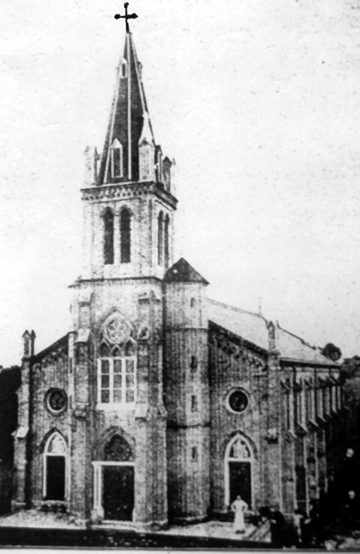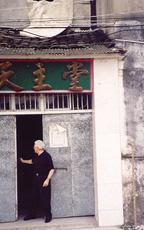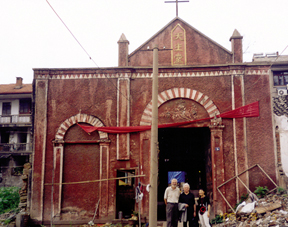A journey into history
Faithful parishioners help in the quest to find two curches served by Scarboro missioners in China early in the last century
By Cynthia Chu
October 2005
Return to Table of Contents
Print Article
This is the story of a quest in search of two churches in China where Scarboro missioners had served early in the last century. One was in the city of Lishui and the other in the city of Jinhua. For Fr. Ray O’Toole, Fr. Roger Brennan and I, three Scarboro missioners working in China today, this was a journey into history.
Beginning in Lishui, we stopped at the bookstore next to our hotel to buy a city map and asked the sales clerks if they knew of a Catholic church in the city. This was not a simple enquiry because the general public would not know a Protestant church from a Catholic one. To our surprise, someone in the bookstore thought there was a church by the river, near a bridge. That gave us a start.
We strolled down a street toward the general direction given us. As we walked, we kept an eye out for older people who may have been in the community since those early years. Roger spotted a woman at a corner store who looked old enough to know of the church. She did not. However, an elderly customer standing next to me overheard the conversation and told us that her church-going neighbour might know. She walked us to her neighbour’s house, handed us over to her, said goodbye and left. She never showed any hesitation, only trust and an eagerness to help.
Mrs. Pan, her neighbour, listened as we explained that we were looking for a Catholic church. Hearing this, 86-year-old Mrs. Pan dropped everything and led us through winding alleyways to the Lishui church by the river.
The first thing we saw was the site where the Sisters’ residence used to be. Directly across the road is the rectory, which is now used as the church. Mrs. Pan told us that the priest, Fr. Mo, celebrates Sunday mass there once every month or two. When Fr. Mo is there, about 100 people attend mass. Other Sundays when he is not there, about 40 people gather at the church to share the Word of God. At Christmas and other special celebrations, as many as 200 people may come. Fr. Mo is stationed at the church in Qingtian (about an hour away) and has other churches to attend to as well.
A middle school now stands where the original church and a school for orphans used to be. During the Cultural Revolution (1966-76), the four-foot cross on the steeple was cast down and almost split in half. Mrs. Ren, a slight woman of 73 years of age, had salvaged the cross and she brought it down from the second floor to show us. A brave woman indeed.
Inside the church Bishop Turner’s picture hung next to a picture of Pope John Paul II. Bishop Turner was another early Scarboro missioner to China. There was some confusion among the people regarding Turner’s nationality. One woman thought he was Canadian, another that he was Italian.
While we were talking, a Mrs. Fang came along and told us stories about the church in Qingtian. The old church there was also taken down and a beautiful, much bigger church was built at another site. A photo of the new church hung in the hallway of the church in Lishui. The women told us that Fr. Paul Kam, another early Scarboro missioner, was buried in Qingtian. We were happy that at long last our mission community would know of our brother’s resting place.
Mrs. Fu, a retired teacher, then joined us. I was delighted to discover that she spoke standard Chinese rather than the local dialect. It had been a little difficult conversing with the others.
Mrs. Fu gave us an old photo of the original church with the cross still standing above the steeple. She told us that the government offered to build a new and bigger church in Lishui but on the other side of the city. It is a dilemma for the parish, she said, because most of the parishioners are elderly and live in the immediate neighbourhood. It would be difficult for them to get across the city to attend church. A parish committee had been negotiating with the authorities to have the new church rebuilt on the original premises for some years, with little progress. Then along came the young, educated and energetic Mrs. Fu who has chosen to spend her retirement years (in China women retire at 55 and men at 60) working on this committee. She is hopeful that the negotiations will push forward more effectively.
She then took us to the burial site of Fr. Aaron Gignac (Zhan Sheng De) and Fr. James McGillivray (Zhao Du Chao). During the Cultural Revolution, the tombs of these Scarboro priests were damaged. Fr. Gignac’s tombstone was completely destroyed. Mrs. Fang’s brother happened to be the caretaker of the cemetery at the time and helped arrange to rebury the two men in a lovely spot upon the hill in the cemetery grounds. They buried the two together in one Chinese-style tomb.
Every November 5, the parishioners visit the tomb to pay their respects to “two young men who gave their lives to the Chinese people,” said Mrs. Fu and the others. After weeding the area, they sprinkle holy water on the tomb and on those who come to pay their respects—a ritual we took part in when we were there.
Our hosts invited us to a meal with the parish community after the tomb visit. However, we thankfully declined their hospitality. We were simply exhausted after a very full day.
The church in Jinhua
The following morning, we took a bus to Jinhua and then hopped in a cab because this time we had an address for the church. Well, it was not to be that easy.
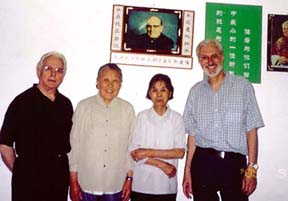 Scarboro missioners to China Fr. Ray O’Toole and Fr. Roger Brennan inside the Lishui church with parishioners Mrs. Fang and Mrs. Ren.
Scarboro missioners to China Fr. Ray O’Toole and Fr. Roger Brennan inside the Lishui church with parishioners Mrs. Fang and Mrs. Ren.
The cab driver took us to a church on the same street, but it turned out to be a Protestant church. She then continued along the street but could not find the address. She asked for help at a store, but no one knew. She tried the phone number on the address but the phone was not in service. Eventually she gave up and let us out of the cab.
We continued asking people on the street and finally learned that there were two sections to this road, separated by a traffic light. So we retraced our route and at the lights we crossed to the other section.
Again, as in Lishui, we kept looking for older people to ask for assistance. However, this time help came in the form of a tiny tot. She excitedly took us to her grandmother who told us that there was indeed a Catholic church down the road but she did not know exactly where. She said most of the church buildings had been torn down and developed into residential housing.
We thanked her and trotted down a road that looked like a dead end. Just as we were beginning to lose hope, a church-like façade suddenly appeared to our right. Then a cross came into view. There was construction all around so it took us a while to make our way to the site.
Our excitement was short lived because behind the archway of the façade were homes.
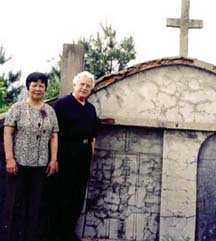 Mrs. Fu and Fr. O’Toole at the tomb of early China missionaries Fr. Aaron Gignac and Fr. James McGillivray. Lishui.
Mrs. Fu and Fr. O’Toole at the tomb of early China missionaries Fr. Aaron Gignac and Fr. James McGillivray. Lishui.
“Where is the church?” we asked a woman. She told us we were in the right place and pointed to a locked door to one side. She said the woman behind that door could help us. She knocked and an elderly woman opened the door to us.
Her name was Mrs. Chen and she took us to a church that was smaller than the one in Lishui and more run down. On the outside wall hung four laminated pictures of our founder Monsignor Fraser and parishioners standing in front of the church.
Mrs. Chen told us many things but her dialect was difficult to understand. At that moment, a Mrs. Cai appeared. Apparently the first woman we met sought out Mrs. Cai after leaving us to Mrs. Chen. Mrs. Cai spoke standard Chinese and communication flowed again.
The laminated photos on the outside wall were the ones Fr. Michael Traher mailed to them last summer at the request of Fr. Guo. Young Fr. Guo (36 years of age) studied in the Beijing seminary and was appointed pastor here in South China. At the time of our visit, he was in Shaanxi Province in the north, his first vacation and home visit with his mother in three years, Mrs. Cai said. Two Sisters also helped out at the church. However, with Fr. Guo away, they were out preaching and evangelizing in nearby towns.
The Jinhua church used to be much larger. The façade marks the entrance to what was once the church compound. Inside and on either side of the façade were meeting areas for parishioners—one for the men and one for the women—and a courtyard. What is now the church used to be the men’s meeting room. The church itself had been on a hill with a staircase leading up from between the meeting areas. All these are now gone, replaced by storied residential buildings. The rectory is now used as office space. It was not hard to picture Monsignor Fraser in this house where he lived for nine years. The Chinese respectfully called him, “Fan Gong”. Fan is his Chinese surname and Gong is a respectful title.
Mrs. Cai said that the parish is asking the government to return one third of the original property to make the church more visible again. They have a lot of work to do yet and the parish community is aging fast.
In two short days we covered a lot of Scarboro Missions’ history in this region of China. We also marvelled at how another Scarboro priest, Fr. Gerald Sherry, found his way to Lishui some years ago, despite not being able to speak any Chinese.
We are deeply grateful to the local people and to the faithful parishioners who made our journey to the past possible. Lots of prayers are in order for both church communities as they make their way towards the future.
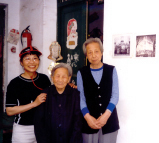 Scarboro missioner Cynthia Chu with Mrs. Chen and Mrs. Cai, faithful parishioners throughout the years, outside their now small church in Jinhua, China.
Scarboro missioner Cynthia Chu with Mrs. Chen and Mrs. Cai, faithful parishioners throughout the years, outside their now small church in Jinhua, China.
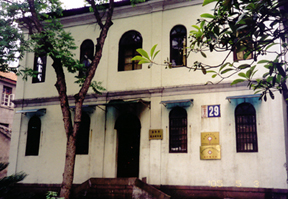 The rectory of the church in Jinhua where Scarboro Missions’ founder Monsignor John Mary Fraser lived. He arrived in Jinhua in 1932 with five seminarians and remained there for nine years. China.
The rectory of the church in Jinhua where Scarboro Missions’ founder Monsignor John Mary Fraser lived. He arrived in Jinhua in 1932 with five seminarians and remained there for nine years. China.
Return to Table of Contents
Print Article
